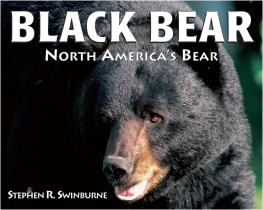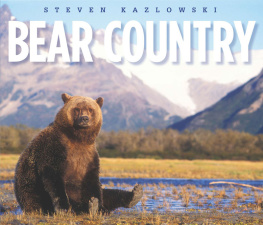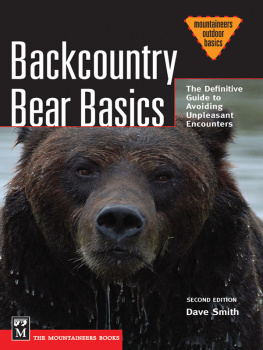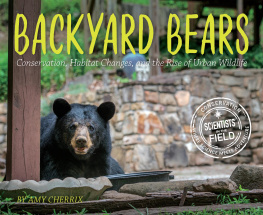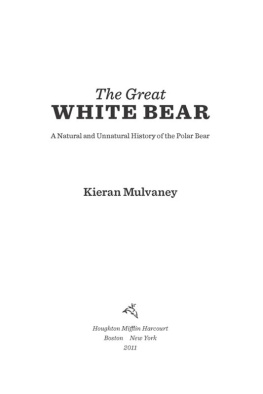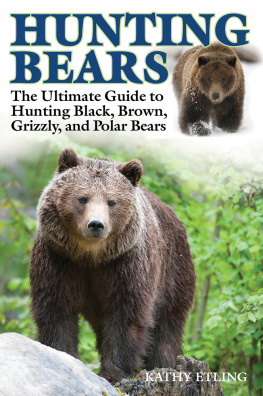BLACK BEAR
NORTH AMERICAS BEAR
STEPHEN R. SWINBURNE
BOYDS MILLS PRESS
HONESDALE, PENNSYLVANIA
Im very grateful to the following black bear biologists and naturalists: Forrest Hammand, Ben Kilham, Alcott Smith, Sue Morse, and Mark Trenent. Thanks also to Gary Alt and Lynn Rogers for their books and lectures on black bears that proved so helpful in my research. Im especially grateful to Dr. Lynn Rogers of the Wildlife Research Institute and North American Bear Center for reviewing the manuscript. Finally, many, many thanks to my friend Craig Dicken. Thanks for driving with me from Vermont to Pennsylvania to check bear dens in February. Your wonderful photographs at the bear den bring the chapter to life.
Photograph credits:
Steve Swinburne: Pages top left, bottom left, top right
K. M. Anderson: Page (bottom)
Craig Dicken: Pages
Ben Kilham: Pages
Jerome Robinson: Page (right)
National Park Service: Pages
Yellowstone National Park: Page (top)
To my old friend Dennis McDermott and our literary heroes, John Burroughs and Henry David Thoreau
S. S.
Copyright 2003 by Stephen R. Swinburne
All rights reserved
Boyds Mills Press, Inc.
815 Church Street
Honesdale, Pennsylvania 18431
Printed in China
Library of Congress Cataloging-in-Publication Data
Swinburne, Stephen R.
Black bear : North Americas bear / by Stephen R. Swinburne. 1st ed.
[48] p. : col. ill. , photos. ; cm.
Includes index.
Summary:An examination of black bears, their behavior and habitat.
ISBN 978-1-59078-023-7 (hc)
ISBN 978-1-59078-798-4 (pb)
ISBN 978-1-62979-261-3 (e-book)
1. Black bear Juvenile literature. 2. Bears Juvenile literature. (1. Black bear. 2. Bears.)
I.Title.
599.74/ 446 21 QL737.C27S95 2003
2002117182
First edition
First Boyds Mills Press paperback edition, 2010
The text of this book is set in 13-point Garamond Book.
15 14 13 12 11 10 9 8 7 (hc)
10 9 8 7 6 5 4 3 2 1 (pb)
Prologue
O N A PEACEFUL J UNE EVENING in the Adirondack Mountains of New York, I sit down with my family to a delicious lake trout dinner. Before I have a chance to take my first bite, a waiter shouts, Look, a bear!
About twenty people rush to a window overlooking the dining-room garden. We watch a black bear moving slowly but surely across the lawn to a bird feeder. The bear stands on its hind legs, then reaches up and bashes the feeder. The bears first swipe brings the feeder crashing down, spilling seeds upon the ground. Dinner is served.
Quietly we ease open the dining-room door and gather on the porch to watch the bear, which is no more than thirty feet away.
Thats the third feeder Ive hung in the last month, whispers the owner of the lodge. Three strikes, Im out. The bear wins. No more feeding the birds. Or bears!

BLACK BEAR FACTS
Black bears come in many different colors. They can be black, brown, blonde, cinnamon, reddish, and all shades in between. Along certain parts of the British Columbia coast in Canada white black bears and blue black bears can even be found. Most black bears east of the Mississippi River are black, while most bears in the west are either black or brown. Black bears often show a splash of white on their chests; some individuals have a very definite white V. Within a family, black and brown cubs can occur.

black

brown
The bear hunkers low over the protein-rich sunflower seeds, shielding his booty like a child protecting a new toy. Sunflower seeds have twice the calories per gram of beechnuts or acorns. The animal uses its long tongue to painstakingly extract the seeds from the mat of grass. We can hear the rhythmic chuffing of the bears breathing and the contented sound of bear teeth chomping against seed. The bear remains still, head down, eating for nearly twenty minutes. Only once does it lift its head to look at us.
I continue watching the bear in the fading twilight. Its a beautiful animalbig, wild, and free. Ive seen black bears many times in my life, but Im always amazed at their size and power and how quickly they can move. Black bears can run fastup to thirty miles per hourfor short periods. I remember driving a thickly wooded road in Vermont in early June when a half-mile up ahead I saw a large black bear. When I reached the place where the bear crossed the road, there was no sign of it. The forest had swallowed it whole. But on the other side of the road, where the bear had come from, there was plenty of sign of black bear. A massive beaver lodge the size of a large living room lay demolished. Logs and branches, thick and thin, lay strewn like a thrown fistful of pick-up sticks. I reasoned the bear had torn apart the lodge searching for young beavers to eat.
Eating. When a bear isnt sleeping or playing its usually eating. Its one of the things bears do best. They eat whatever is available at different times of the year. Black bears will kill and eat small prey, such as deer fawns, and will also scavenge on animal carcasses. They relish ants and bees. Yet nuts (acorns, beechnuts), fruits (blueberries, raspberries, blackberries, apples, mountain ash), leaves, and roots form about 80 percent of a black bears diet.
Our Adirondack bear has done a good job of vacuuming the spilled sunflower seeds from the ground. In the soft light from the lodges windows I can see the bear finally move. It sniffs the ground for any missed seed. Then it turns and, led by its nose, saunters off into the forest.
Despite its teddy bear image and the raids on our backyard bird feeders and garbage cans, the black bear is at home in the woods. It is a wild creature that has evolved in its natural habitat over hundreds of thousands of years. The bear has lived here a lot longer than we have. Its home is in these Adirondack Mountains and in forests across much of North America. And as I go back to my trout dinner, I sense these woods are richer knowing that black bears live here. I may never see that bear again, but Im happy knowing its out there as my wild neighbor.

